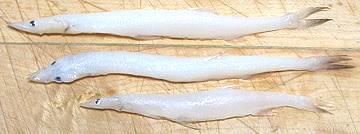
[Family Salangidae (Icefishes, Noodlefishes) of Order Osmeriformes (Smelts)]
These fish are related to trout, salmon and smelts, but remain very small and most species live no more than a year. They retain larval features, including lack of color, uncalcified bones and no scales. They are found in salt, brackish and fresh water along the East Asian coast from Korea south to Viet Nam, in Chinese rivers and lakes, and around Japan and the Philippines. They are generally nearly transparent when alive, but turn milky white upon death. They are economically important in China, and popular culinary fish in China, Japan and the Philippines.
More on Varieties of Fish
(very large page).
There are quite a few species, but little information is available to me on many of them. They pretty much all look like the ones I've written up here, and most species are probably caught and similarly eaten, at least locally. I have lumped them as small, medium and large.
 [Silver Fish;Neosalanx tangkahkeii | also Chaohu,
Bai Fan Yu (China); Neosalanx pseudotaihuensis]
[Silver Fish;Neosalanx tangkahkeii | also Chaohu,
Bai Fan Yu (China); Neosalanx pseudotaihuensis]
These fish are native to freshwater lakes and reservoirs in eastern and central China and have been introduced to other regions. They are economically important in the regions where they are harvested. They can grow to 3 inches, but the largest in the photo above was 2-5/8 inches long. They live for one year, spawning in the spring and then dying. These fish are IUCN Red Listed LC (Least Concern).
These fish are sold in Asian markets, usually in frozen blocks of random sized fish from 1/2 inch to 2-1/2 inches long - usually labeled "Silver Fish" or "Silverfish". They're also sold dried in tubs or bags labeled "Silver Anchovy", but they are not at all related to anchovies.
These fish don't have a lot of flavor, but they're an interesting addition to thin soups. To use them, run warm water over one corner of the block with a mesh strainer below. Run the water until as many fish as you want have fallen off the block into the strainer. Wrap the block and put it back into the freezer compartment. Toss the fish into the soup just before you take it off the heat.
In China, they are often mixed with eggs to make a pan fried omelet.
Large ones are also lightly battered and deep fried for use as a topping
for Asian salads.
 [Silver Fish; Dulong (Philippine); Shira-uo (Japan); Lapsha-ryba (Russia);
Salangichthys microdon]
[Silver Fish; Dulong (Philippine); Shira-uo (Japan); Lapsha-ryba (Russia);
Salangichthys microdon]
This fish is a bit longer than those described above (growing to nearly 4 inches). They are a saltwater species, so available around Japan and the Philippines, but also as far north as the Russian Far East. They enter rivers to spawn.
These fish can be prepared the same as Chinese Icefish or Chinese
Noodlefish, depending on size. They are very popular in Ilocos in the
northern Philippines, for omelets eaten for breakfast or to accompany
beer, and are also dried. In the Philippines they are also used for a
simmered dish with various seasonings and vinegar, eaten with rice.
In Japan, both large and small Icefish are eaten as sashimi
(raw fish). They are kept alive so they can be served in their
translucent state, as they turn milky white soon after death.
Photo by opencage distributed under license Creative Commons
Attribution-ShareAlike v2.5 Generic.
 [Chinese Icefish; Chinese Whitebait; Cá Ngan Trung Hoa (Viet);
Salanx chinensis]
[Chinese Icefish; Chinese Whitebait; Cá Ngan Trung Hoa (Viet);
Salanx chinensis]
This is a saltwater fish, but it also lives in brackish waters and enter fresh water to spawn. It can be found from temperate China south to northern Vietnam. In China, it has been stocked in some lakes and reservoirs with varying results. This fish can grow to 6-3/8 inches long, but the largest of the photo specimens was 5-3/8 inches, just about average for this fish. The photo specimens were purchased from an Asian market in Los Angeles (San Gabriel) frozen in an 8 ounce tray. Cost was 2016 US $5.50 per pound. Chinese Noodlefish is IUCN Red Listed DD (Data Deficient).
In China, these fish are often lightly battered, deep fried and
eaten with a dip. In Japan, large Icefish are eaten as sashimi
(raw fish). They are kept alive so they can be served in their
translucent state, as they turn milky white soon after death.